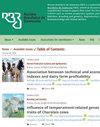牛至叶和绿茶提取物作为饲料添加剂对奶牛产奶量、血液学和抗氧化特性的影响
IF 1.2
4区 农林科学
Q3 Agricultural and Biological Sciences
Revista Brasileira De Zootecnia-Brazilian Journal of Animal Science
Pub Date : 2022-01-01
DOI:10.37496/rbz5120210150
引用次数: 1
摘要
-我们的目的是评估添加牛至(Origanum vulgare)或绿茶(Camellia sinensis L.)的效果。提取物(单独或联合)对奶牛采食量、产奶量、血液学和抗氧化特性的影响。试验采用完全区组设计,将16头体重为526.3±10.2 kg、泌乳前1 / 3的荷斯坦奶牛和16头荷斯坦-盖尔奶牛进行分组,并及时重复测量。对照组(CON)、饲粮中添加0.056%的牛至提取物(OR)、0.028%的绿茶提取物(GT)和分别添加0.056%的牛至提取物和绿茶提取物的混合(MIX)。监测血液学和抗氧化指标。数据进行方差分析,将阻滞、处理、天数及其相互作用视为固定效应,将动物和残留物视为随机效应。在荷斯坦奶牛中,与CON相比,GT提高了采食量和产奶量;在荷斯坦-吉尔杂交奶牛中,与对照相比,OR增加了采食量,GT提高了产奶量,与对照相比,GT和OR降低了嗜酸性粒细胞浓度;OR组中性粒细胞浓度和中性粒细胞与白细胞的比值最高。与对照相比,OR提高了过氧化氢酶(CAT)活性,而GT提高了还原型谷胱甘肽浓度。与OR相比,MIX处理降低了CAT活性,红细胞(DCFER)和血浆(DCFPLA)中氧化二氯荧光素浓度最低,嗜酸性粒细胞浓度高于GT和OR。不同基因组提取物对采食量和产奶量的影响不同。单独或联合饲喂绿茶和牛至提取物对泌乳奶牛抗氧化指标有显著影响。本文章由计算机程序翻译,如有差异,请以英文原文为准。
Milk production and hematological and antioxidant profiles of dairy cows supplemented with oregano and green tea extracts as feed additives
- We aimed to evaluate the effects of the addition of oregano ( Origanum vulgare ) or green tea ( Camellia sinensis L. ) extracts (separately and associated) on feed intake, milk production, and hematological and antioxidant profiles of dairy cows. For that purpose, 16 Holstein and 16 Holstein-Gyr cows with 526.3±10.2 kg and within the first third of lactation were distributed according to a complete block design with measurements repeated in time. Treatments were control (CON), addition of 0.056% of oregano extract (OR), addition of 0.028% of green tea extract (GT), addition of a mixture of OR and GT extract (0.056% each) in the diet (MIX). Hematological and antioxidant profiles were monitored. Data were subjected to ANOVA, with block, treatment, days, and their interactions considered as fixed effects and animal and the residue as random effects. In Holstein cows, GT increased feed intake and milk yield compared with CON; in Holstein-Gyr crossbred cows, OR showed increased intake and GT increased milk yield compared with CON. Compared with CON, GT and OR decreased eosinophils concentration; OR showed the highest neutrophils concentration and neutrophils to leukocyte ratio. Compared with CON, OR presented increased catalase (CAT) activity, while GT increased the reduced glutathione concentration. The MIX treatment reduced CAT activity compared with OR, presented the lowest concentration of oxidized dichlorofluorescein in the erythrocytes (DCFER) and plasma (DCFPLA), and increased eosinophils concentration compared with GT and OR. Extracts differently affected feed intake and milk yield depending on genetic group. Feeding green tea and oregano extracts separately or associated distinctly affects the antioxidant indicators of lactating dairy cows.
求助全文
通过发布文献求助,成功后即可免费获取论文全文。
去求助
来源期刊
CiteScore
1.90
自引率
0.00%
发文量
25
审稿时长
8 weeks
期刊介绍:
The Revista Brasileira de Zootecnia (RBZ; Brazilian Journal of Animal Science) encompasses all fields of Animal Science Research. The RBZ publishes original scientific articles in the areas of Aquaculture, Biometeorology and Animal Welfare, Forage Crops and Grasslands, Animal and Forage Plants Breeding and Genetics, Animal Reproduction, Ruminant and Non-Ruminant Nutrition, and Animal Production Systems and Agribusiness.

 求助内容:
求助内容: 应助结果提醒方式:
应助结果提醒方式:


